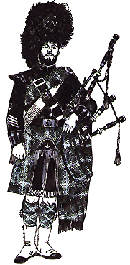
 While the ancient Scot loved to play the Scottish harp
Clarsach and the violin, the former for chamber music and the latter for fast
reels, strathpeys and light dances, yet the pipe was too used for the same
purpose.
While the ancient Scot loved to play the Scottish harp
Clarsach and the violin, the former for chamber music and the latter for fast
reels, strathpeys and light dances, yet the pipe was too used for the same
purpose.The Plob-Mhor or great Highland Bagpipe is pre-eminently the national instrument not only of the Highland man but of all Scotland. All Scottish regiments whether Highland or Lowland have pipes.
In the British Isles there were various forms of the bagpipe in use (1)The Lowland or Northumbrian Bagpipe, (2)The Irish Union (or Willeann) pipes, (3) The Piob-Mhor, or the great Highland Bagpipe.
Of these three the Highland bagpipes are the only ones blown by the mouth. The wind for others are supplied by the bellows fastened underneath the arm of the performer. Some of these instruments had a much greater compass then the Highland Bagpipe, and some had a sweeter tone, but all lacked the stirring and warlike sound of the Piob-Mhor.
This instrument is the type used by the pipers today. Its stirring strains have through the years carried the Scots to greater heights in battle, and the piper has always held a prominent position in the life of the Clan.
Just who first played the bagpipe and how it got into Scotland has been a matter of great argument for and conjecture for hundreds of years. Most athorities agree it was brought to Britian by the Romans.
Ancient Roman coins found in Italy and in England depict peipers on one side of them and ancient Grecian and Roman sculpture show pipers using a primituve type of bagpipe.
In England too there are ancient carved and sculpted figures of pipers in the old churches, some of them making a joke of the pipes.
In the Lincoln Cathedral, for instance, we see a stained window, representing a piper holding a squalling cat under his arm while he has the tail in his mouth.
The picture of a monley blowing the instrument can be seen at St John's Church Cirencester; while at Bolston parish church there is depicted an orchestra of bears, one fo which is a performer of the pipes.
In Scotland itself are several paintings of the Highland warpipe as we know it
today, with of course some changes.
Copyright 1995-1997 DISCscribe Ltd. - All Rights Reserved.